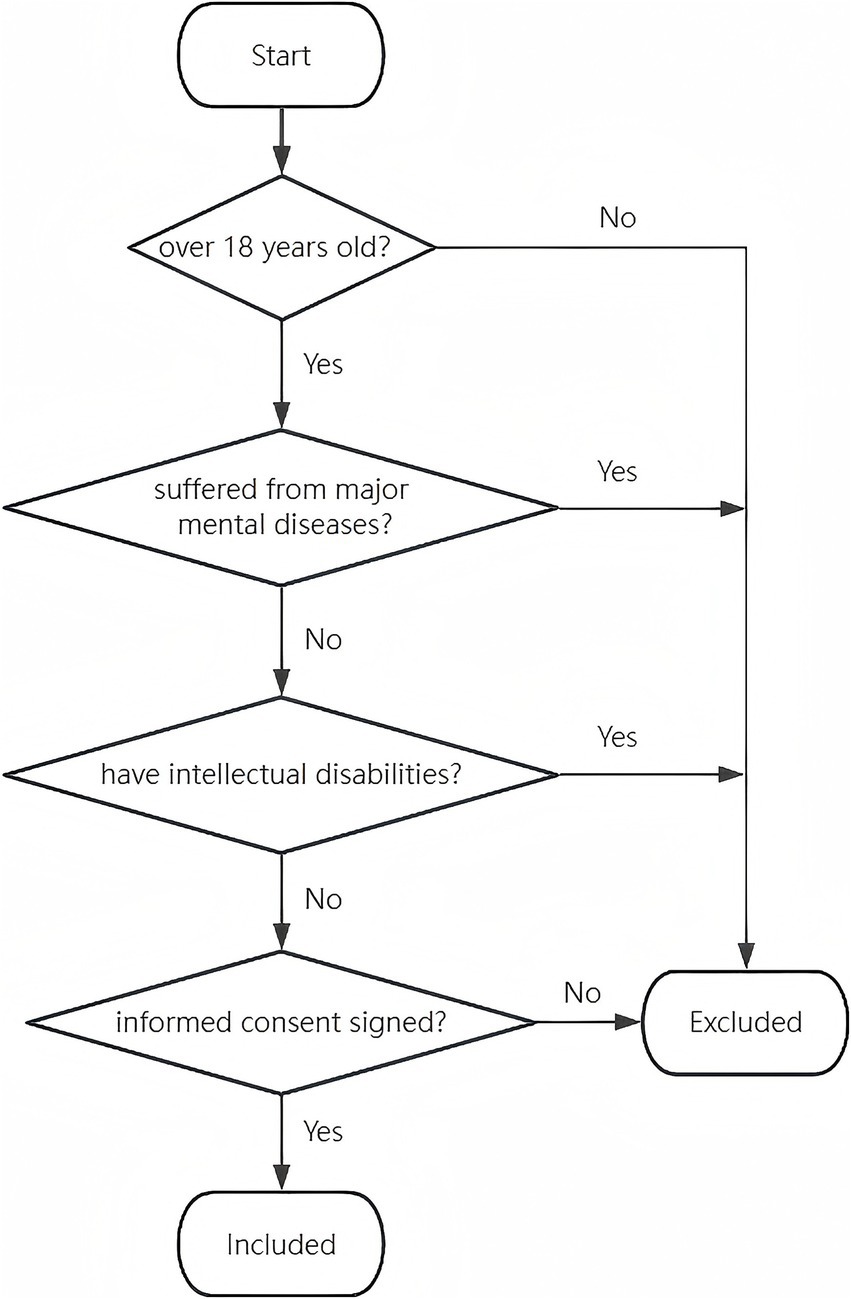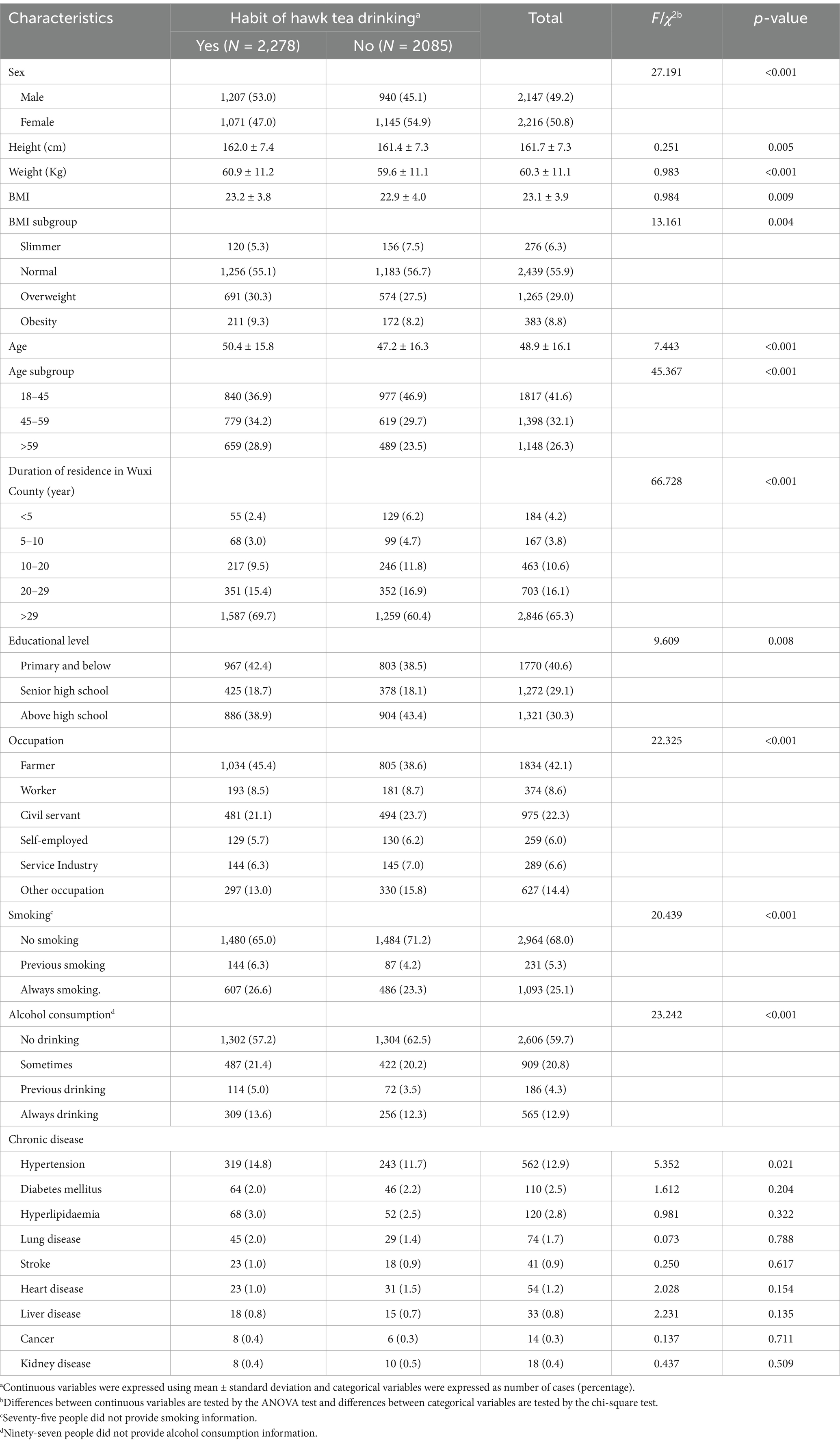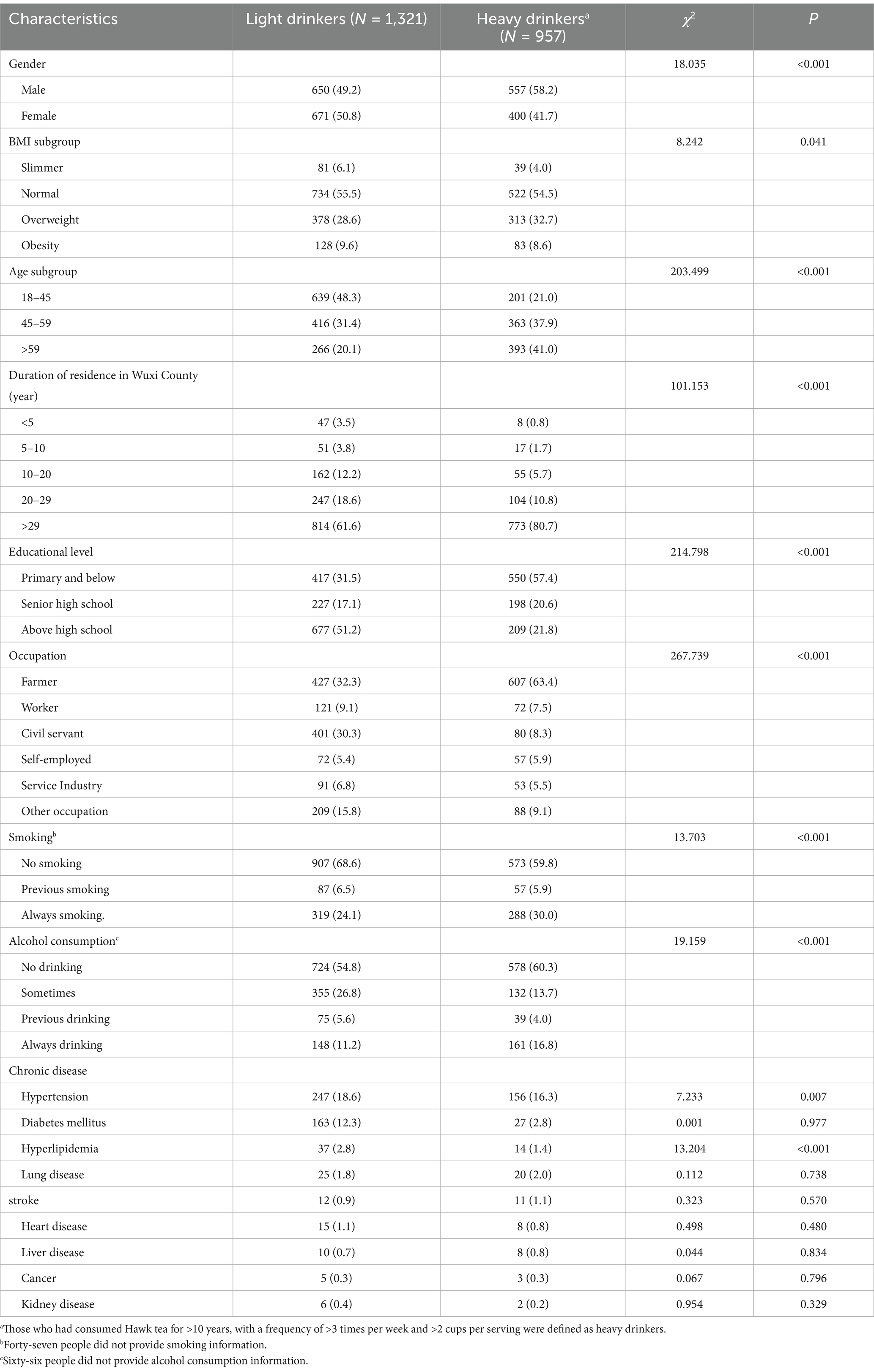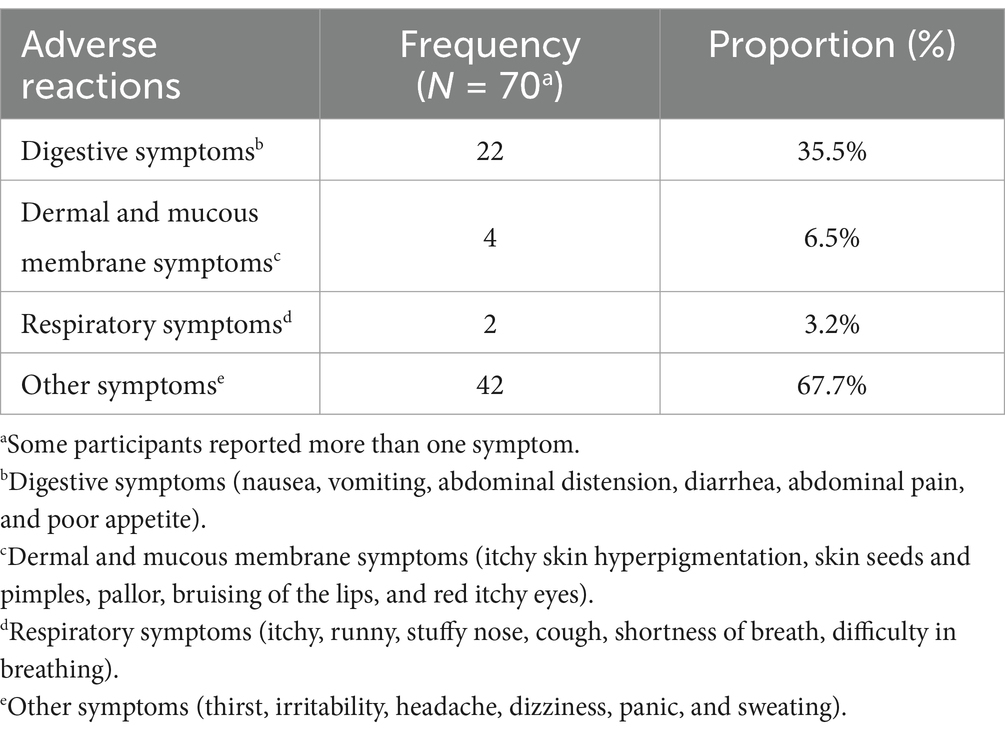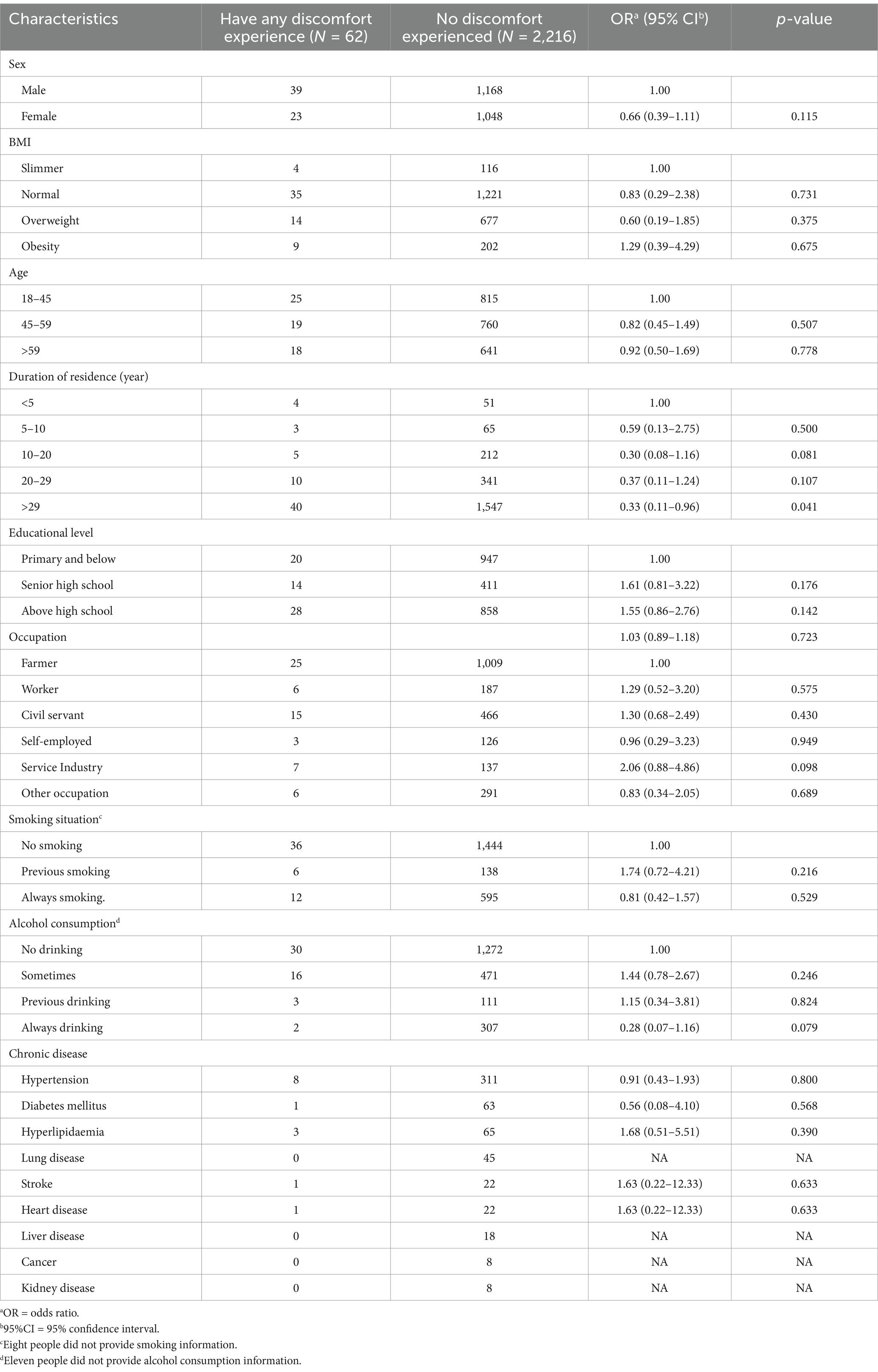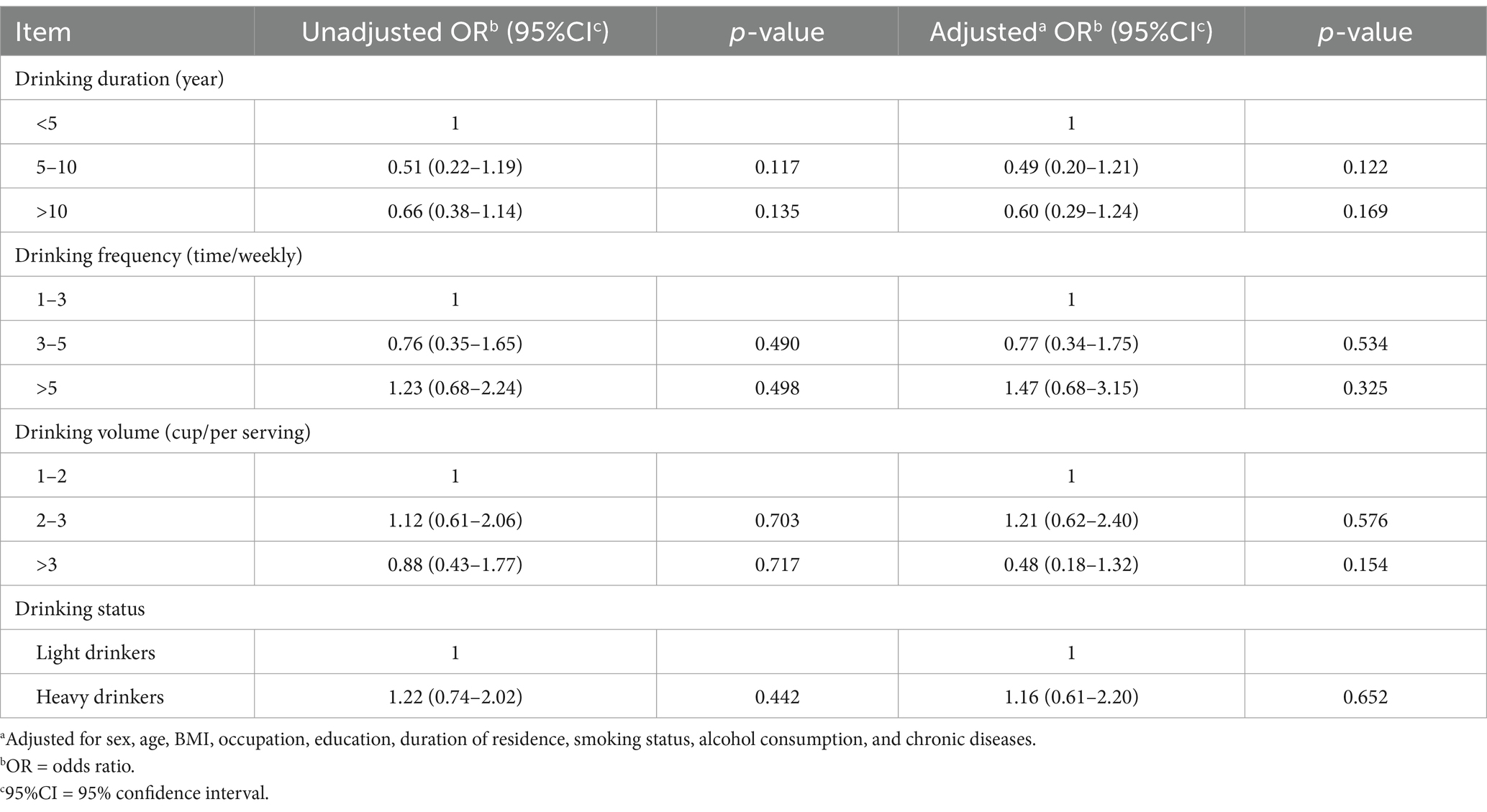- 1College of Public Health, Chongqing Medical University, Chongqing, China
- 2College of Traditional Chinese Medicine, Chongqing Medical University, Chongqing, China
- 3College of Chinese Materia Medica, Chongqing University of Chinese Medicine, Chongqing, China
- 4The College of Traditional Chinese Medicine, Chongqing Medical University, Chongqing, China
Background: A herbal tea of leaves and stems of Litsea coreana, named Hawk tea locally, has been traditionally consumed in some places in southwestern China. However, there is no human based evidence about the safety and health effects of drinking hawk tea. This study aims to illustrate possible healthy effects of consuming hawk tea in a population with a habit of drinking hawk tea in Chongqing city.
Methods: A hawk tea producing area located in Chongqing city was selected as the study setting, and residents were randomly designated. Self-designed questionnaires were administered to collect data, including basic information, the behaviors of consumption of hawk tea, and various health information.
Results: Among the 4,363 respondents, 2,278 (52.2%) drank tea more 1 time per month and 957 (42.0%) were heavy drinkers. Among 2,278 Hawk tea drinkers, 62 reported various symptoms after drinking, and logistic regression showed no relationship between the symptoms reported and the characteristics of consumption (duration, frequency, and volume) (p > 0.05). In addition, heavy hawk tea drinkers had a lower risk of hyperlipidaemia than light hawk tea drinkers (p < 0.001, 95% odds ratio = 0.26).
Conclusion: With the long history of consumption in the population and the effects on health as were shown in this study, hawk tea poses no detectable health risks to consumers and shows some benefit to metabolism of lipids. It can be recognized and recommended as a safe and healthy herbal beverage for people to consume in daily life. Further interventional studies on its safety and health benefits are warranted.
1 Introduction
Hawk tea is made from Litsea coreana Levl. var. lanuginosa, a perennial, indeciduous, broad-leaved tree which is different from Camellia sinensis tree (green tea) (1–3). This wild plant is mainly distributed in mountainous areas of southwest China, such as Chongqing, Sichuan, and Hubei (4, 5). Drinking hawk tea has a long history, and the earliest records of hawk tea consumption can be traced back to the Ming Dynasty. It is believed that hawk tea has the advantageous of “quench thirst, brighten-eyes, strengthen the stomach, detoxification, and storage stable” (6, 7). The buds or leaves of L. coreana Levl. var. lanuginosa are collected and processed in a way like green tea, with the steps of fixing, rolling, and frying. The soup of hawk tea is amber in color, with a mellow and refreshing taste, sweet aftertaste, and the unique aroma of camphor plant. Hawk tea was popular in rural area of southwest China in past and now is extending to cites gradually. It was reported that current drinkers of hawk tea were more than 30 million in China (8).
Modern pharmacological studies have shown that flavonoids, polysaccharides, polyphenol, saponins, and volatile oils are the major components of hawk tea. Among which, flavonoids are the most abundant active ingredients in L. coreana leaves. In a review of Xuejing Jia and Ming Yuan, at least 29 monomeric compounds and corresponding structures were identified (8), including Hypericin, Isoquercitrin, Kaempferol-3-O-β-D-galactoside, Quercetin, Echinacoside, Quercetin, Kaempferol. The total flavonoids in dried hawk tea leaves range around 10.48–22.30 mg/g (9). Flavonoids have various health benefits. Xiao et al. (10) found that L. coreana leaves have a strong antioxidant capacity and can effectively scavenge DPPH (2,2-Diphenyl-1-picrylhydrazyl) free radicals. In addition, the flavonoid components in L. coreana leaves had significant protective effects on the liver injury from chemicals by Hu et al. (11) and Xu et al. (12). In addition, L. coreana leaves has been found to have hypoglycaemic, hypolipidemic, and hypocholesterolaemia effects in animals. For example, Chen et al. (13) showed that L. coreana leaf extracts can reduce the activity of α-glucosidase and lipase at certain concentrations to achieve hypoglycaemic and hypolipidemic effects (14–16). Litsea coreana leaves contain minerals, amino acids, vitamins, alkaloids, and other nutrients (17–19). These studies implies that drinking hawk tea may have various health benefits, which makes hawk tea a promising health beverage against those widely spreading chronic diseases.
Although there is a long history of hawk tea drinking in some areas of southwest China and sparse animal studies had been conducted to elaborate the possible health effects and related mechanisms, the direct evidence for human populations with drinking habit is absent when considering to promote hawk tea consumption as a function beverage in a wider population. Therefore, we investigated a population with drinking habit of hawk tea to further assess its safety and health effects.
2 Materials and methods
2.1 Study site
Wuxi County, located in western China, as a major producer of hawk tea has a tradition of consuming hawk tea. The population in Wuxi County is approximately 380 thousand population, and 5 out of 19 towns were randomly selected as investigation sites.
2.2 Study participants
Residents aged >18 years were eligible as participants, except for those who suffered from major mental diseases or intellectual disabilities that prevented normal communication. All the respondents provided informed consent to participate. This study was approved by the Ethics Committee of Chongqing University of Chinese Medicine (2023005).
2.3 Contents of the questionnaire
The questionnaire included basic information about the respondents (sex, age, height, weight, duration of residence, occupation, education level, smoking consumption, and alcohol consumption), current habits of hawk tea intake (duration, frequency, and amount of consumption), various adverse reactions after drinking hawk tea, and current health conditions.
2.4 The conducting of survey
The survey was conducted in the summer of 2023, and the enumerators were trained to standardize its implementation. Subsequently, enumerators visited residents’ houses individually along the streets of the selected towns in one direction without returning, and eligible members of the household were invited to participate in the survey. Questionnaires were administered via face-to-face interviews to individuals who accepted the invitation. Figure 1 showed the procession of selecting the participants.
2.5 Data analysis
Questionnaire data were entered into Epidata 3.1 with a double entry. SPSS27.0 was used for statistical analysis. Descriptive analyses were performed using means and standard deviations for quantitative data and inter-group comparisons were performed using t-tests. The rates and constitutive ratios for categorical data and comparisons were calculated using the chi-squared test. The OR (odds ration) and its 95% CI (confidence intervals) between hawk tea consumption expressed as category variable and health outcome such as adverse reaction and chronic disease expressed as binary variable were estimated by using logistic regression. A p-value <0.05 was considered to be statistically significant.
3 Results
3.1 Characteristics of participants
In total, 4,663 persons accepted our invitation, 4,363 (93.6%) provided sufficient information for the analysis. Among them, 2,147 (49.2%) were male and 2,216 (50.8%) were female, and the mean age was 48.9 ± 16.1 years. The largest proportion of age was 18–45 years old (41.6%). The average BMI was 23.1 ± 3.9 kg/m2, with more than half (2,439, 55.9%) of the population having a BMI in the normal range. Farmer was the largest group of the survey respondents (42.1%), and their education level was predominantly primary school and below (40.6%). The prevalence of current smoking was 25.1% and current alcohol consumption was 12.9%. Of the nine common chronic diseases, hypertension had the highest prevalence of 12.8% in the total population, and cancer had the lowest prevalence of 0.9% in the total population.
Among the included respondents, 2,278 (52.2%) reported having a habit of drinking hawk tea (at least once per month). People with or without a habit of hawk tea drinking differ according to sex, height, weight, body mass index (BMI), age, duration of residence, education level, occupation, smoking habits, alcohol drinking, and hypertension. The characteristics of the respondents are presented in Table 1.
3.2 Drinking behaviors of hawk tea drinkers
Among the 2,278 participants with the habit of drinking hawk tea (at least once per month), Heavy drinkers (those who had consumed hawk tea for >10 years, with a frequency of >3 times per week and >2 cups per serving) accounted for 42% of all drinkers. Heavy drinkers were more likely to be male, older, with longer duration residence in local, lower education, farmer, smoker, alcohol drinker, and lower proportion of hypertension and diabetes (all p < 0.05) (Table 2).
3.3 Reported discomforts after drinking hawk tea
As shown in Table 3, among the 2,278 people who were habitual drinkers of hawk tea, 2.7% (62 people) reported that they had experienced at least more than one type of slight discomfort after drinking hawk tea. Among the discomforts reported, symptoms which was not clearly defined with a specific category had the proportion of 67.7%, such as thirst, irritability, headache, dizziness, panic, sweating, followed by digestive symptom (35.5%), dermal and mucous membrane symptoms (6.5%) and respiratory symptoms (3.2%) (Table 3).
3.4 Univariate analysis of the factors related to discomfort experiences
Except for those who lived in WuXi for > 29 years and had a lower risk of adverse reactions compared to others, the discomfort experience was not associated with other factors, such as sex, age, BMI, education level, occupation, smoking status, and alcohol consumption (Table 4).
3.5 The hawk tea consumption behavior and discomfort experience
In the multivariate logistic regression analysis, hawk tea drinking duration, frequency, volume, and drinking status were not significantly associated with discomfort experiences, even after adjusting for all available covariates (all p-values > 0.05) (Table 5).
3.6 Hawk tea consumption and chronic diseases
After adjusting for confounders such as sex, age, BMI, occupation, education, local residence time, smoking status, and alcohol consumption, we found that Heavy Hawk tea drinkers had a lower risk of hyperlipidaemia than light drinkers (p < 0.001, odds ratio = 0.26), and no statistically significant differences were noted in the risk of other chronic diseases between heavy and light drinkers (all adjusted p-value >0. 05) (Figure 2).
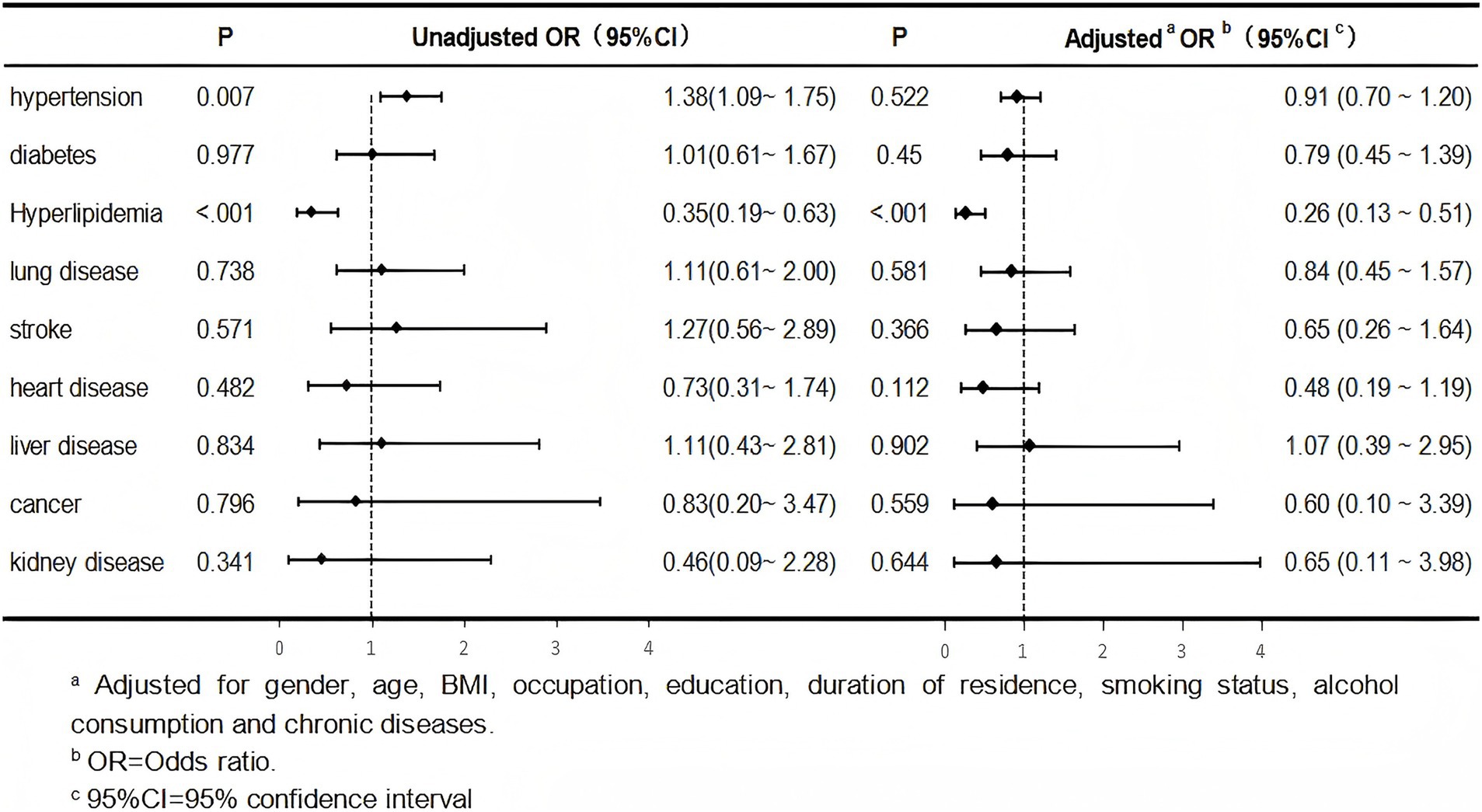
Figure 2. Multivariate logistic-analysis of the risks of chronic diseases in heavy drinkers compared to light drinkers.
4 Discussion
In this study, we found that consumption of hawk tea was highly prevalent in Wuxi County, with more than half of the samples drinking hawk tea more than once a month, and 55.2% of the drinkers had a history of drinking it for > 10 years. This indicated that the habitual drinking of hawk tea was more common among local residents.
Regarding the safety of drinking Hawk tea, multivariate logistic regression revealed no significant association between the occurrence of discomfort symptoms and the duration, frequency, or amount of Hawk tea consumption. The lack of a dose–response (in terms of duration, frequency, and amount) of adverse effects suggests that these uncomfortable reactions may be induced by chance with other unknown stimulators or health conditions, rather than by the consumption of hawk tea. The toxicological studies on high dose of total flavonoids extract of hawk tea leaves on rats showed no observed side effects (8). Saponin which are rich in hawk tea have been reported to induce some acute symptoms in cold blooded animal, but not in mammals (20). Because we cannot identify the relationships between adverse reactions and any the drinking characteristics in this study, the possible compounds which may responsible for these reported discomforts was not clear, and allergic reaction to the ingredients of hawk tea may be possible and cannot be excluded.
We also found that hawk tea consumption did not increase the risk of developing common chronic diseases. In contrast, hawk tea consumption for >10 years, more than three times a week, and more than two cups each time, which we defined as heavy drinking, reduced the risk of hyperlipidaemia. The protective effect of hawk tea on hyperlipidaemia is consistent with the findings of Feng et al. (21), who reported that L. coreana extract (HTE) induced the transcription of the low-density lipoprotein receptor by inhibiting free cholesterol uptake. It also reduces the production of very low-density lipoproteins.
Regarding the mechanisms of the benefits of hawk tea, the flavonoids and polyphenols in hawk tea have the features of antioxidant (22–25), anti-inflammatory (26, 27) and other biological activities (28). These substances scavenge free radicals and inhibit the inflammatory response. Volatile oil components in hawk tea inhibit Escherichia coli and Staphylococcus aureus (29, 30). Hawk tea also contains saponins (31, 32), which may promote digestion and relieve gastrointestinal dyskinesia. More specific, total flavonoids extracts of hawk tea was found increased the expression of peroxisome proliferator-activated receptor alpha (PPARalpha) in high fat diet fed rat liver. These benefits were associated with increased superoxide dismutase (SOD) and decreased malondialdehyde (MDA) in high fat diet fed rat liver (33). Metabolic profile analysis identified dozens of metabolites which can adjust pathways of MAPK and PI3K/AKT to exert antioxidant activity of hawk tea (34). Secondly, extracts from hawk tea can suppress the IRE1/mTORC1/TNF-α-regulated inflammatory response initiated in peritoneal macrophages, exerting anti-inflammatory and immunomodulatory effects (35). In addition, extracts of hawk tea can down regulate the expression of adipose differentiation-related protein (ADRP) in the liver and improve the lipids profiles (36).
The strength of this study is that the sample size was large and the consumption of hawk tea was popular at the study site, which allowed us to detect the related adverse events and health effects. A limitation of this study is its cross-sectional design with self-reported information; the measurement of tea consumption, health outcomes, and confounders may have been biased by recall, and some other confounders were not included.
5 Conclusion
Long-term regular consumption of hawk tea has little chance of resulting in any recognizable acute adverse effects on consumers. The self-reported discomforts after drinking hawk tea seem to be coincidence with other symptom inducers. If discomfort symptom occur after drinking, temporary isolation from hawk tea may help. Besides, habitually drinking hawk tea may benefit lipid metabolism. Hawk tea can be generally recognized as a safe herbal beverage with health functions. However, further intervention studies are warranted to further confirm its function and safety in animal and population studies.
Data availability statement
The raw data supporting the conclusions of this article will be made available by the authors, without undue reservation.
Ethics statement
The studies involving humans were approved by The Ethics Committee of Chongqing University of Chinese Medicine. The studies were conducted in accordance with the local legislation and institutional requirements. The participants provided their written informed consent to participate in this study.
Author contributions
HZ: Data curation, Writing – original draft. XP: Writing – original draft. HH: Investigation, Writing – review & editing. QH: Investigation, Writing – review & editing. BY: Investigation, Methodology, Writing – review & editing. WC: Project administration, Writing – review & editing. YZ: Writing – review & editing, Formal analysis.
Funding
The author(s) declare that financial support was received for the research and/or publication of this article. This research was supported by Chongqing Health Commission Bayu Qihuang Scholars Support Project (grant number 2023-23-14), Chongqing Education Committee Science and Technology Research Project (grant number KJZD-M202215102) and Chongqing Municipal Science and Technology Bureau Chongqing Municipal Talent Plan ‘contract system project’ (grant number cstc2024ycjh-bgzxm0111).
Conflict of interest
The authors declare that the research was conducted in the absence of any commercial or financial relationships that could be construed as a potential conflict of interest.
Generative AI statement
The author(s) declare that no Gen AI was used in the creation of this manuscript.
Publisher’s note
All claims expressed in this article are solely those of the authors and do not necessarily represent those of their affiliated organizations, or those of the publisher, the editors and the reviewers. Any product that may be evaluated in this article, or claim that may be made by its manufacturer, is not guaranteed or endorsed by the publisher.
Supplementary material
The Supplementary material for this article can be found online at: https://www.frontiersin.org/articles/10.3389/fpubh.2025.1588368/full#supplementary-material
References
1. Wang, JH, Qi, X, and Yao, SL. Investigation of Guizhou hawk tea raw material plants. Southwest China J Agric Sci. (2010) 23:983–5. doi: 10.16213/j.cnki.scjas.2010.03.039
2. Dai, QL, and Zhu, HX. Investigation and evaluation of eagle tea germplasm resources in Chongqing. Acta Agric Zhejiangensis. (2022) 34:447–56. doi: 10.3969/j.issn.1004-1524.2022.03.04
3. Xu, JL, and Xiao, W. Chinese ancient tea-hawk tea. Mod Chin Med. (2012) 14:60–3. doi: 10.13313/j.issn.1673-4890.2012.02.002
4. Xi, PY, Wang, JH, and Yao, SL. Advances in research and utilization of characteristic tea resources of hawk tea. Guizhou Sci. (2015) 33:88–96.
5. Ai, AT, Li, YL, Chen, LX, and Lyu, LT. Research progress and development and utilization status of hawk tea. GuangDong Tea Industry. (2021) 3:35–40.
6. Jun, L, and Jian, Z. Advances in studies of Litsea coreana Levl. Var. J Sichuan Agric Univ. (2005) 23:247–52. doi: 10.16036/j.issn.1000-2650.2005.02.025
7. Kong, DG, Zhao, Y, Li, GH, Chen, BJ, Wang, XN, Zhou, HL, et al. The genus Litsea in traditional Chinese medicine: an ethnomedical, phytochemical and pharmacological review. J Ethnopharmacol. (2015) 164:256–64. doi: 10.1016/j.jep.2015.02.020
8. Jia, X, and Yuan, M. Hawk tea, a traditional and healthy natural beverage in south China Non-Alcoholic Beverages. (2019) 10:107–128. doi: 10.1016/B978-0-12-815270-6.00004-9
9. Bin, L. Simultaneous determination of seven flavonoids in hawk tea by pressurized solvent extraction-HPLC. Chin J Pharm Anal. (2010) 30:1424–7. doi: 10.16155/j.0254-1793.2010.08.010
10. Xiao, X, Xu, L, Hu, H, Yang, Y, Zhang, X, Peng, Y, et al. DPPH radical scavenging and postprandial hyperglycemia inhibition activities and flavonoid composition analysis of hawk tea by UPLC-DAD and UPLC-Q/TOF MSE. Molecules. (2017) 22:1622. doi: 10.3390/molecules22101622
11. Hu, CM, Qi, C, Xie, XF, Liu, HF, Qi, D, and Jun, L. Effect of total flavonoids of Litsea coreana on hepatic steatosis in rats with alcoholic fatty liver in vitro. Chin J Pharmacol Toxicol. (2013) 27:193–9.
12. Xu, T, Hu, S, Liu, Y, Sun, K, Luo, L, and Zeng, L. Hawk tea flavonoids as natural Hepatoprotective agents alleviate acute liver damage by reshaping the intestinal microbiota and modulating the Nrf2 and NF-κB signaling pathways. Nutrients. (2022) 14:3662. doi: 10.3390/nu14173662
13. Chen, Z, Zhang, D, Guo, JJ, Tao, W, Gong, RX, Yao, L, et al. Active components, antioxidant, inhibition on metabolic syndrome related enzymes, and monthly variations in mature leaf hawk tea. Molecules. (2019) 24:657. doi: 10.3390/molecules24040657
14. Yang, LC, Chun, F, Yang, CJ, Han, Y, Lian, RT, and Yu, ZW. Study on hypoglycemic activity of several common tea plants in vitro. Food Sci Technol. (2020) 45:62–6. doi: 10.13684/j.cnki.spkj.2020.09.010
15. Lu, YX, Zhang, Q, Li, J, Sun, YX, Wang, LY, Cheng, WM, et al. Antidiabetic effects of Total flavonoids from Litsea Coreana leve on fat-fed, Streptozotocin-induced type 2 diabetic rats. Am J Chin Med. (2010) 38:713–25. doi: 10.1142/s0192415x10008184
16. Lyu, XW, Li, J, Jin, Y, Zhang, L, and Wang, JQ. Study on the improvement effect and mechanism of total flavonoids of Litsea coreana on insulin resistance in hyperlipidemia rats. J Chin Med Mater. (2009) 32:1568–71. doi: 10.13863/j.issn1001-4454.2009.10.032
17. Yuan, M, Jia, XJ, Ding, CB, Yuan, S, Zhang, ZW, and Chen, YE. Comparative studies on bioactive constituents in hawk tea infusions with different maturity degree and their antioxidant activities. Sci World J. (2014) 2014:838165:1–7. doi: 10.1155/2014/838165
18. Jia, XJ, Li, P, Wan, JB, and He, CW. A review on phytochemical and pharmacological properties of Litsea coreana. Pharm Biol. (2017) 55:1368–74. doi: 10.1080/13880209.2017.1302482
19. Wang, YX, Deng, YL, Yao, SL, Wang, Y, and Wang, JH. Comparison of physical and chemical quality of leopard skin camphor hawk tea in 4 counties of Guizhou. Acta Agric Zhejiangensis. (2021) 33:142–9. doi: 10.3969/j.issn.1004-1524.2021.01.17
20. Sharma, K, Kaur, R, Kumar, S, Saini, RK, Sharma, S, Pawde, SV, et al. Saponins: a concise review on food related aspects, applications and health implications. Food Chem Adv. (2023) 2:100191. doi: 10.1016/j.focha.2023.100191
21. Feng, J, Yang, J, Chang, Y, Qiao, L, Dang, H, Luo, K, et al. Caffeine-free hawk tea lowers cholesterol by reducing free cholesterol uptake and the production of very-low-density lipoprotein. Commun Biol. (2019) 2:173. doi: 10.1038/s42003-019-0396-4
22. Dong, S, Tong, X, Li, J, Huang, C, Hu, C, Jiao, H, et al. Total flavonoid of Litsea coreana leve exerts anti-oxidative effects and alleviates focal cerebral ischemia/reperfusion injury. Neural Regen Res. (2013) 8:3193–202. doi: 10.3969/j.issn.1673-5374.2013.34.003
23. Jia, X, Dong, L, Yang, Y, Yuan, S, Zhang, Z, and Yuan, M. Preliminary structural characterization and antioxidant activities of polysaccharides extracted from hawk tea (Litsea coreana var. lanuginosa). Carbohydr Polym. (2013) 95:195–9. doi: 10.1016/j.carbpol.2013.03.005
24. Wu, L, Zhou, WB, Xie, NN, Xu, N, and You, LF. Study on fermented hawk tea beverage and its antioxidant activity. Technol Food Industry. (2021) 42:168–73. doi: 10.13386/j.issn1002-0306.2020080052
25. Li, ZR, Shao, QJ, Wu, QM, and LI, Y. Study on the content of phenolic compounds and antioxidant activity in different maturity hawk teas. Guihaia. (2024) 44:1170–81.
26. Liu, Y, Wang, XH, Chen, QB, Luo, LY, Ma, M, Xiao, B, et al. Camellia sinensis and Litsea coreana ameliorate intestinal inflammation and modulate gut microbiota in dextran sulfate sodium-induced colitis mice. Mol Nutr Food Res. (2020) 64:e1900943. doi: 10.1002/mnfr.201900943
27. Yu, B, Zhang, D, Yan, XW, Wang, JW, Yao, L, Tan, LH, et al. Comparative evaluation of the chemical composition, antioxidant and antimicrobial activities of the volatile oils of hawk tea from six botanical origins. Chem Biodivers. (2016) 13:1573–83. doi: 10.1002/cbdv.201600099
28. Xu, Q, Zhou, Y, Zhao, J, Yao, S, and Wang, J. Effect of storage time on biochemical characteristics and antioxidant activity of hawk tea (Litsea coreana) processed by boiling water fixation. Food Sci Nutr. (2020) 8:6182–91. doi: 10.1002/fsn3.1913
29. Qin, Z, Feng, Z, Wang, WS, and Feng, JZ. Optimization of extraction process of volatile oil from hawk tea and its antibacterial activity. Food Sci Technol. (2018) 43:257–61. doi: 10.13684/j.cnki.spkj.2018.09.044
30. Wang, TY, Li, J, Ge, JF, Li, CY, Jin, Y, Lü, XW, et al. Preliminary study of total flavonoids from Litsea coreana Levl. On experimental adjuvant-induced arthritis in rats. Am J Chin Med. (2008) 36:899–912. doi: 10.1142/s0192415x08006338
31. Wang, YJ, Ji, HF, Sun, JL, Zhang, L, Zhang, GH, and Wang, YQ. Study on ultrasonic extraction and antibacterial activity of total saponins from hawk tea. Food Sci Technol. (2012) 37:226–9. doi: 10.13684/j.cnki.spkj.2012.09.005
32. Yu, JP, and Gu, LQ. Chemical constituents of Guizhou hawk tea. J Plant Resour Environ. (2001) 3:61–2.
33. Wang, JQ, Li, J, Zou, YH, Cheng, WM, Lu, C, Zhang, L, et al. Preventive effects of total flavonoids of Litsea coreana leve on hepatic steatosis in rats fed with high fat diet. J Ethnopharmacol. (2009) 121:54–60. doi: 10.1016/j.jep.2008.09.029
34. Jiang, S, Zhang, H, Song, Y, Xiao, M, Hu, H, Yu, S, et al. Metabolic profiles and potential antioxidant mechanisms of hawk tea. Sci Rep. (2025) 15:3600. doi: 10.1038/s41598-025-88160-8
35. Zhong, J, Ma, T, Huang, C, Liu, H, Chen, Z, Cao, L, et al. Flavonoids from Litsea coreana decreases TNF-α secretion from peritoneal macrophages in adjuvant-induced arthritis rats via UPR pathway. Am J Chin Med. (2014) 42:905–19. doi: 10.1142/S0192415X14500578
Keywords: hawk tea, food safety, population survey, lipid metabolism, cross-sectional study
Citation: Zhang H, Pu X, Huang H, Huang Q, Yu B, Cao W and Zhang Y (2025) A population-based study on safety and health of drinking Litsea coreana tea (hawk tea). Front. Public Health. 13:1588368. doi: 10.3389/fpubh.2025.1588368
Edited by:
Yan Liu, Southwest University, ChinaReviewed by:
M. Iqbal Prawira-Atmaja, Indonesia Research Institute for Tea and Cinchona, IndonesiaAhmed Abd El-Moniem Amer, Egyptian Drug Authority, Egypt
Copyright © 2025 Zhang, Pu, Huang, Huang, Yu, Cao and Zhang. This is an open-access article distributed under the terms of the Creative Commons Attribution License (CC BY). The use, distribution or reproduction in other forums is permitted, provided the original author(s) and the copyright owner(s) are credited and that the original publication in this journal is cited, in accordance with accepted academic practice. No use, distribution or reproduction is permitted which does not comply with these terms.
*Correspondence: Yong Zhang, emhhbmd5b25nY3FAbGl2ZS5jbg==; Weiguo Cao, Y2Fvd2VpZ3VvQGNxY3RjbS5lZHUuY24=
†These authors share first authorship
 Han Zhang
Han Zhang Xiyu Pu
Xiyu Pu Haijun Huang3
Haijun Huang3 Weiguo Cao
Weiguo Cao Yong Zhang
Yong Zhang